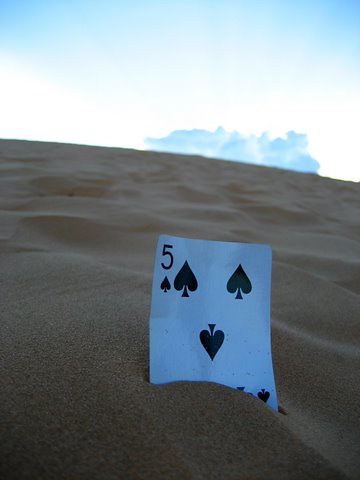The origin of this game was trying to think about a game that helped give students enough experience to intuit the rules for how operations with signed numbers affect inequalities. I think this is doubly hard for students because they don't have much intuition for signed numbers, and learn both integer operation and inequality rules by memorization rather than understanding.
I love playing cards as a material for signed numbers because the red and black make such a nice positive and negative visual. (For more integer games, see this collection elsewhere on the blog.) I thought about students somehow constructing expressions, but I couldn't think of anything not clunky. I knew we wanted comparison, and I like War as a comparison structure. That made me think of the exciting moment of war, playing down extra cards on a tie.
When I played around with the cards, though, it didn't get at inequalities because each player was changing the value of only one side of the comparison. A big no-no in the context we want. So the played cards had to effect both players' values. It seemed confusing to have both players reveal at the same time, so I decided that - at least to start - players should take turns, even though that makes the optimal strategy pretty determinable. (If it's not a word it should be.)
After students get the strategy, go to the variation where both players flip at the same time or the dealer has one less card. If playing with middle schoolers for integer operations practice, try the flipping off the top variation.
I think this is a good educational game, but only close to a good strategy game. I can't quite figure out what's missing, so if you have a variation or adaptation to try, please let me know.
Evaluating this on my game design framework:
- Goal(s). Gain experience with effect of integer operations on inequalities. Works well. Also good for gaining experience with integer computation.
- Structure. The game generates a lot of these situations and the cards guarantee a mix of operations and values.
- Strategy. Pretty simple. On variation becomes a pretty nice bluffing game, but not intensely strategic.
- Interaction. What you do completely depends on opponent.
- Surprise. Hidden information and opponent plus randomization of cards helps here.
- Catch-Up. Victory is almost always possible.
- Inertia. Might be too simple for loads of play, but good enough for the objective.
- Rules. The idea of applying your card to both is non-intuitive, and remembering suits-operations connections is hard. You might want specialty cards
- Context. No context, but all the variations generated engagement from the preservice teachers.

Photo credit: Abulic Monkey @ Flickr

Problems on my blog CoolMath, while simple to understand for high-school pupils, will be very tough to solve, and some of the problems there will help them understand factors/powers of numbers. No doubt, problems are difficult and geeky there, but they will definitely help students to understand and expand, to be part in something math related (like the olympiads). Please visit cool--math.blogspot.in
ReplyDeleteThis comment has been removed by a blog administrator.
ReplyDelete